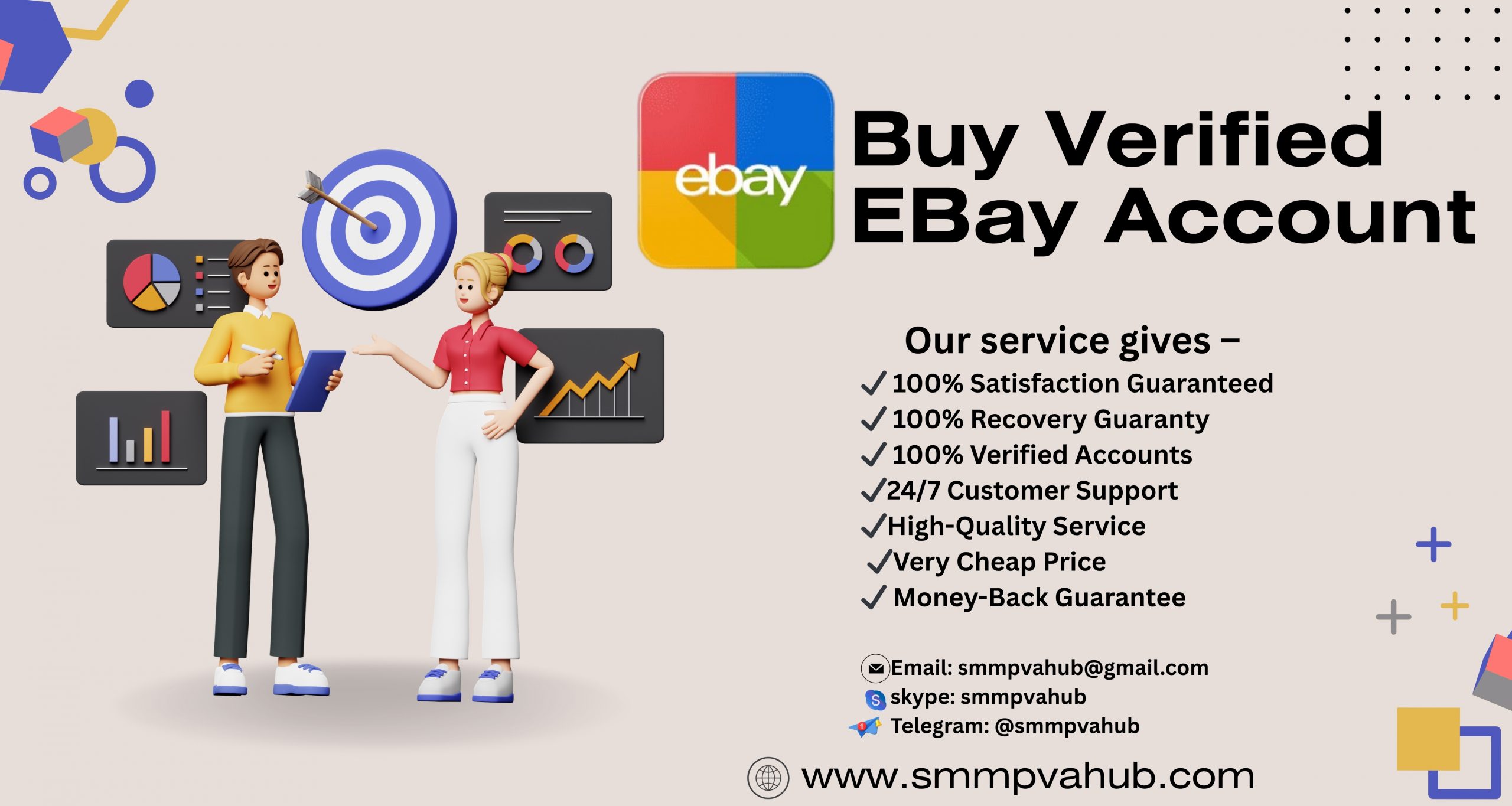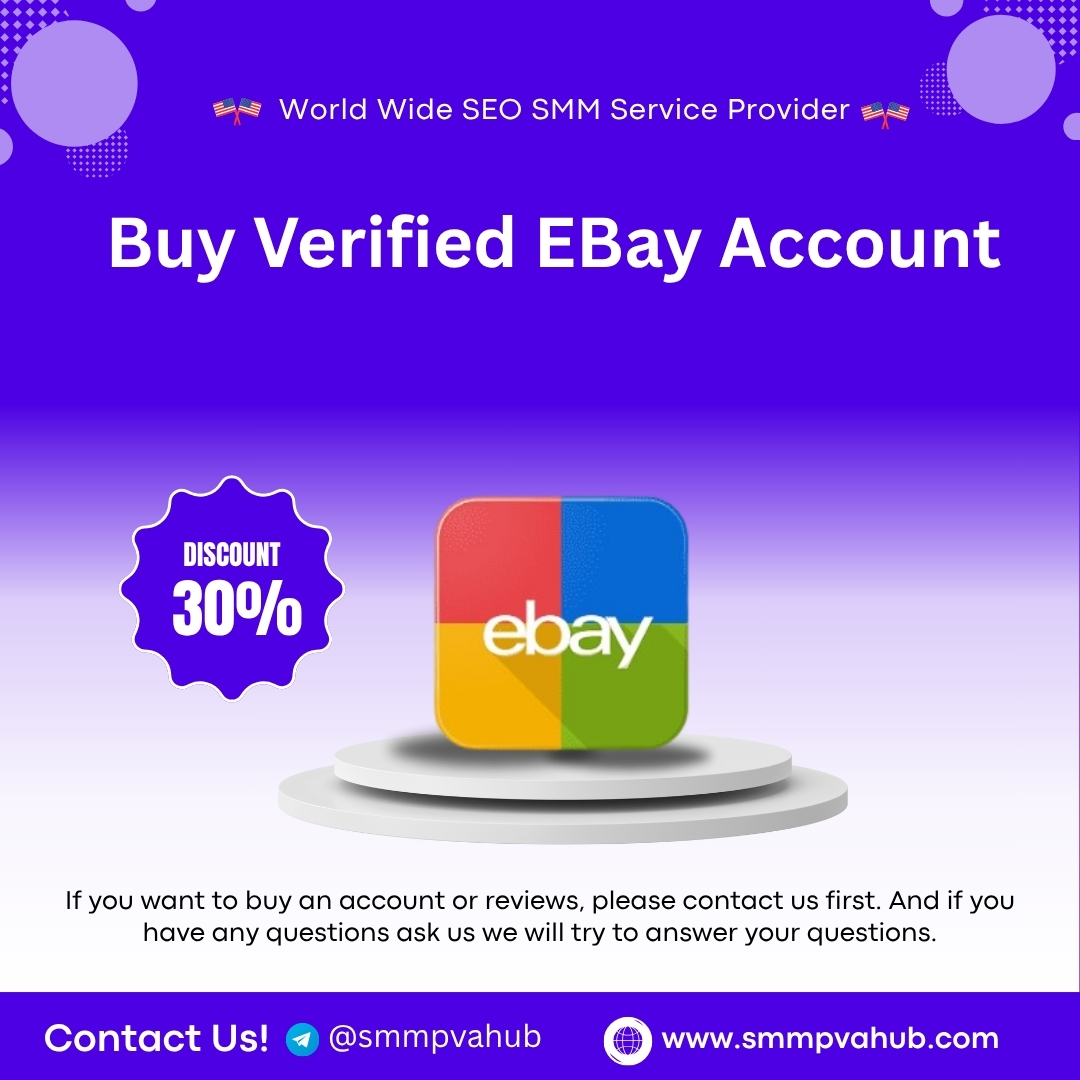Buy Verified EBay Account
Buy Verified EBay Account Ebay is one of the world’s largest online marketplaces. It connects millions of buyers and sellers globally
Whether you’re hunting for unique collectibles, affordable deals, or hard-to-find items, Ebay offers endless possibilities. Founded in 1995, it has grown into a platform where almost anything can be bought or sold. From electronics and fashion to antiques and rare finds, the choices are vast.
Ebay’s auction-style listings, alongside fixed-price options, make it a versatile space for diverse shopping needs. Sellers can also reach a wide audience, turning unused items into extra income. This blog will explore how Ebay works, why it’s so popular, and tips to get the most out of it. Whether you’re new or experienced, there’s always something to learn about this dynamic platform.
Getting Started With Ebay
eBay is a trusted platform for buying and selling almost anything. It offers a massive audience, making it ideal for selling items online. Starting as a seller is straightforward, even for beginners. Let’s walk through the steps to get started efficiently.
Setting Up Your Seller Account
Creating a seller account on eBay is quick and simple. Begin by registering for an account if you don’t already have one. Go to eBay’s homepage and click “Register.” Enter your details, including email and password, to create your account.
Once registered, navigate to the “Sell” section on eBay. Here, you’ll set up your seller profile. Add your payment details for receiving payouts. You can link a bank account or use Payoneer. Verify all information to avoid delays later.
Take time to personalize your seller profile. Include a clear photo or logo and write a short bio. This builds trust with potential buyers.
Choosing The Right Selling Format
eBay offers two main selling formats: auction and fixed price. The auction format lets buyers bid on your item over a set time. This is great for rare or unique items. It builds excitement and can lead to higher prices.
The fixed price format allows buyers to purchase immediately. Use this option for items with consistent market value. It’s faster and straightforward for both seller and buyer.
Research your item before selecting a format. Check similar listings to see which format works best. This helps you make an informed decision and attract more buyers.
Finding Profitable Products
Finding profitable products on eBay can feel like a treasure hunt. With the right strategies, you can uncover items that sell quickly and deliver solid profits. The key is knowing what people want and how to source those items efficiently.

Researching Trending Items
Understanding what’s trending is crucial to finding profitable products. Start by browsing eBay’s “Popular Items” section to see what’s hot right now. Pay attention to categories like electronics, fashion, and collectibles—they often have strong buyer demand.
Take advantage of tools like Google Trends or eBay’s Terapeak Product Research. These tools help you identify search volume and sales history for specific products. Look for items with steady demand but low competition to maximize your chances of success.
Ask yourself this: “Would I buy this?” If the answer is yes, chances are others will too. Think about seasonal trends, upcoming holidays, or emerging tech—these can all influence what people are shopping for.
Sourcing Products Effectively
Once you know what’s trending, it’s time to source your products. Start small by checking local thrift stores, garage sales, or clearance sections in big-box retailers. You’ll be surprised how often you can find hidden gems that sell well online.
If you’re ready to scale, consider wholesalers or dropshipping platforms like Alibaba or SaleHoo. These sources give you access to bulk inventory at lower prices, which can boost your profit margins. Just be sure to vet suppliers carefully to avoid scams or poor-quality goods.
Think about shipping costs and delivery times when sourcing products. Customers value fast and affordable shipping, so choose suppliers who can meet these expectations. A great product won’t sell if it takes weeks to arrive!
Creating Compelling Listings
Crafting effective eBay listings helps attract buyers and boost sales. Clear titles, detailed descriptions, and quality images make items stand out. Engaging content builds trust and encourages purchases.
Creating compelling listings on eBay is the secret sauce to attracting buyers and making sales. A great listing doesn’t just describe your product—it excites, informs, and convinces. Let’s break it down into two key aspects: titles and images.
Writing Attention-grabbing Titles
Your title is the first thing buyers see—it’s your hook. It needs to be clear, specific, and keyword-rich. Think about what a buyer might type in the search bar. Avoid vague titles like “Nice Bag.” Instead, write something like “Leather Crossbody Bag – Brown, Adjustable Strap, Women’s Fashion.” This provides details and uses keywords buyers are likely searching for. Place the most important words (like the brand or type of item) at the beginning of your title. eBay’s search algorithm prioritizes these. Keep it under 80 characters to ensure it’s fully visible.
Using High-quality Images
Your photos are your product’s first impression—they can make or break a sale. Use clear, high-resolution images that show the product from multiple angles. Buyers want to see every detail before they commit. Natural lighting works best, but if that’s not an option, use a well-lit space with a clean, neutral background. Avoid clutter in the frame—it distracts from the product. Show any flaws or imperfections in your item. Transparency builds trust and reduces the chance of returns. Would you buy something without knowing exactly what it looks like? When you combine sharp titles with stunning visuals, your eBay listings will stand out in a sea of competitors. What strategies have you tried to make your listings pop?
Pricing Strategies For Success
When selling on eBay, pricing plays a huge role in attracting buyers and boosting sales. Get it wrong, and your items might sit unsold for weeks. Get it right, and you could see your business thrive. So, how do you find that sweet spot? Let’s dive into practical strategies to nail your pricing game and maximize your success.
Competitive Pricing Tips
Know your competition. Before listing your item, check what similar items are selling for on eBay. Use the “Sold Listings” filter to see the actual prices buyers paid. This gives you a realistic benchmark.
Pricing just below your competitors can grab attention. If others are selling an item for $50, listing yours at $48.99 could make all the difference. Small price differences often sway buyers.
Don’t forget to factor in shipping costs. Offering free shipping might mean slightly raising your price, but it often makes your listing more appealing. Buyers love knowing exactly what they’ll pay upfront.
When To Use Auctions Vs. Fixed Pricing
Use auctions for rare or highly sought-after items. If you’re unsure of an item’s value, auctions let the market decide its worth. Start with a low opening bid to encourage initial interest, but set a reserve price if needed to protect your item’s value.
Fixed pricing works better for common items. Buyers looking for everyday products often prefer the certainty of a fixed price. Plus, it allows you to list your item for longer without the time pressure of an auction.
Consider using both strategies. For instance, if an item doesn’t sell at auction, relist it with a fixed price. This gives you the chance to reach different types of buyers.
What’s your pricing strategy? Try experimenting with these tips and see what works best for your eBay store. Remember, small tweaks can lead to big results!
Boosting Visibility On Ebay
Struggling to get your eBay listings noticed? You’re not alone. With millions of sellers competing for attention, standing out can feel overwhelming. But visibility is key to making sales, and improving it doesn’t have to be complicated. Let’s dive into some practical strategies to make your eBay shop shine.
Optimizing For Ebay Search
Did you know that eBay’s search algorithm works differently than Google’s? It’s called Cassini, and it prioritizes listings based on relevance, seller performance, and listing quality. To rank higher, focus on crafting clear and specific titles. For example, if you’re selling “Nike running shoes,” don’t just write “Nike shoes.” Add details like “Nike Men’s Running Shoes Size 10 – Black & White.”
Descriptions matter too. Avoid generic wording and provide detailed information about the product, including dimensions, condition, and any unique features. Use bullet points to make it easier for buyers to skim through.
Another tip: Use high-quality images. Buyers often skip listings with blurry or poorly lit photos. A clean, well-lit image can significantly boost clicks.
Leveraging Promotions And Discounts
Want to grab attention fast? Offer promotions. eBay allows you to create markdown sales, volume discounts, and special offers. A “10% off today only” discount can trigger a sense of urgency in buyers.
Consider bundling products to offer value. For instance, if you’re selling phone cases, pair them with screen protectors at a discounted rate. This not only increases your average order value but also appeals to deal-seeking customers.
Don’t forget about free shipping. Many buyers filter listings by “free shipping.” Offering it can make your listing more competitive.
Boosting visibility on eBay doesn’t have to be a guessing game. What strategies have you tried that worked? Let us know in the comments!
Providing Excellent Customer Service
Providing excellent customer service on eBay builds trust and loyalty. Buyers value smooth communication and fair resolutions. As a seller, keeping customers happy boosts your reputation. A great experience leads to positive reviews and repeat buyers. Focus on professionalism and clear policies to keep interactions productive.
Handling Inquiries Professionally
Responding to buyer inquiries quickly shows you value their time. Use polite and clear language in every message. Address their questions with specific details to avoid confusion. If you don’t have an immediate answer, let them know you’re checking. Always thank them for reaching out to you.
Be patient, especially if a buyer seems upset. Stay calm and offer solutions. A positive tone can turn a complaint into a sale. Professional communication builds confidence in your store.
Managing Returns And Refunds
Handle returns and refunds fairly to maintain buyer satisfaction. Outline your return policies clearly in your listings. Ensure buyers know what to expect before purchasing. If a return request arises, accept it graciously and follow eBay’s guidelines.
Process refunds promptly once the returned item is received. Inspect the item carefully to confirm its condition. If the return reason is unclear, politely ask for clarification. Treat every case as an opportunity to show your reliability. Buyers will appreciate a hassle-free process.
Analyzing Performance Metrics
When selling on eBay, understanding how your store is performing is crucial. It’s not just about listing items and waiting for sales—it’s about actively tracking and improving. The more you analyze your performance, the better decisions you can make to grow your business.
Tracking Sales And Feedback
Sales numbers tell you what’s working and what’s not. eBay provides detailed reports that show your sold items, revenue, and customer trends. Check these regularly to spot patterns.
Feedback is equally important. Positive reviews build trust, but negative ones highlight areas for improvement. If you notice repeated comments about slow shipping or poor packaging, tackle those issues immediately. Small changes can lead to big results.
Take a moment to ask yourself—are you paying attention to feedback trends? What do your numbers say about your best-selling categories or products?
Improving Based On Analytics
Data isn’t just numbers; it’s your guide to smarter decisions. If analytics show a dip in sales during specific months, adjust your strategy. Offer discounts or promote seasonal items to boost activity during slow periods.
Use eBay’s traffic report to see how buyers find your listings. If search visibility is low, tweak your titles and descriptions with better keywords. This simple step can make your products more discoverable.
Are you using all the tools available? Look into eBay’s Promotions Manager to create coupons or markdowns based on your analysis. It’s a practical way to turn insights into increased sales.
Analyzing performance metrics isn’t just about numbers. It’s about turning data into actions that grow your business. By staying consistent, tracking feedback, and making targeted improvements, you’ll set yourself up for long-term success.
Staying Ahead In The Marketplace
eBay is one of the most competitive online marketplaces out there. To stay ahead, you need to keep evolving and find ways to stand out. This means staying informed, being flexible, and always looking for new opportunities.
Adapting To Market Trends
Successful eBay sellers keep their fingers on the pulse of the market. Trends change rapidly, and what sold well last month might not be in demand now. Are you updating your listings to match current buyer preferences?
Start by analyzing your sales data. Which items are picking up momentum? Consider using tools like eBay’s Terapeak to uncover trending products and price points. If something isn’t selling, tweak your strategy or let it go.
Sometimes, small adjustments make a big difference. Improving your product photos, updating keywords, or offering discounts can boost visibility. Think of it as fine-tuning your storefront to meet buyer expectations.
Exploring International Selling Opportunities
Have you thought about selling globally? eBay makes it easy to reach buyers in other countries. Expanding your audience could mean more sales and better profit margins.
Start by researching where your products might be popular. For example, vintage clothing sells well in Europe, while electronics might have strong demand in Asia. eBay’s Global Shipping Program simplifies shipping and takes the stress out of international deliveries.
But don’t stop at logistics. Make sure your listings resonate with buyers from different cultures. Use simple language, highlight universal benefits, and factor in time zones for communication. Are you ready to tap into the global market?
Frequently Asked Questions
What Is Ebay And How Does It Work?
EBay is an online marketplace for buying and selling goods. Sellers list items, and buyers bid or purchase directly.
Is Ebay Safe For Online Shopping?
EBay is generally safe with buyer protection policies. Check seller ratings and reviews before purchasing for added security.
How Do I Sell Items On Ebay?
To sell on eBay, create an account, list items with details, set a price, and manage shipping.
What Payment Methods Does Ebay Accept?
EBay accepts PayPal, credit cards, and other payment options. Payment methods may vary based on location and seller preferences.
Conclusion
EBay offers a world of opportunities for buyers and sellers alike. Its platform is simple, accessible, and full of variety. Whether you’re shopping for deals or selling items, eBay makes it easy. By exploring its features, you can find what you need quickly.
Stay mindful of listings, reviews, and pricing to get the best experience. With a little effort, eBay can become your go-to marketplace. So, dive in and enjoy the convenience it brings. Start exploring today and make the most of your buying or selling journey.





Jesse Rogers –
This is the best account. I will buy more next time. Thank you